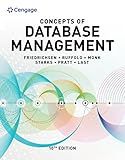Best Database Management Tools to Buy in October 2025

Database Systems: Design, Implementation, & Management



Database Systems: Design, Implementation, & Management



Concepts of Database Management (MindTap Course List)



Data Mining: Practical Machine Learning Tools and Techniques (Morgan Kaufmann Series in Data Management Systems)
- EXCLUSIVE 'NEW' TAG BOOSTS PRODUCT VISIBILITY AND EXCITEMENT.
- ENHANCED FEATURES DELIVER SUPERIOR PERFORMANCE AND CUSTOMER SATISFACTION.
- LIMITED-TIME OFFER CREATES URGENCY, ENCOURAGING QUICKER PURCHASES.



Concepts of Database Management



Customer Relationship Management: Concept, Strategy, and Tools (Springer Texts in Business and Economics)



The Enterprise Data Catalog: Improve Data Discovery, Ensure Data Governance, and Enable Innovation



The Manga Guide to Databases (The Manga Guides)



Data Mining: Practical Machine Learning Tools and Techniques (The Morgan Kaufmann Series in Data Management Systems)



Database Systems: Design, Implementation, & Management


To join two tables in Symfony 5, you can use Doctrine ORM to create associations between entities. In Symfony, entities are PHP classes that represent database tables. You can define relationships between entities using annotations or YAML configuration.
To join two tables, you need to define a relationship between the entities that represent those tables. For example, if you have two entities User and Address, and you want to join them on the user_id column, you can define a OneToMany relationship in the User entity and a ManyToOne relationship in the Address entity.
Once you have defined the relationships between the entities, you can use Doctrine's query builder or DQL (Doctrine Query Language) to retrieve data from both tables in a single query. You can use the join() method in the query builder to join the two tables based on the defined relationships.
By using Doctrine ORM and defining appropriate relationships between entities, you can easily join tables in Symfony 5 and retrieve data from multiple tables in a single query.
What is the syntax for joining tables in Doctrine ORM in Symfony 5?
In Symfony 5, you can join tables using Doctrine ORM by writing DQL queries. Here is the syntax for joining tables in Doctrine ORM:
$query = $entityManager->createQuery( 'SELECT u, p FROM App\Entity\User u JOIN u.profile p WHERE u.id = :userId' )->setParameter('userId', $userId);
$users = $query->getResult();
In this example, we are joining the User entity with the Profile entity using the JOIN clause. The User entity is aliased as u and the Profile entity is aliased as p. The WHERE clause is used to filter the results based on a specific userId.
You can also specify different types of joins such as LEFT JOIN, RIGHT JOIN, and INNER JOIN depending on your requirements.
How to use criteria in join queries in Symfony 5?
In Symfony 5, you can use criteria in join queries by using the Doctrine Query Builder. Here is an example of how you can do this:
// Get the entity manager $entityManager = $this->getDoctrine()->getManager();
// Create a query builder $queryBuilder = $entityManager->createQueryBuilder();
// Build the query with criteria in the join $queryBuilder ->select('p', 'c') ->from('App:Product', 'p') ->leftJoin('p.category', 'c', 'WITH', 'c.name = :categoryName') ->setParameter('categoryName', 'Electronics');
// Get the results $results = $queryBuilder->getQuery()->getResult();
In this example, we are selecting all products and their corresponding categories where the category name is 'Electronics'. You can modify the criteria in the join by updating the 'WITH' condition in the leftJoin function.
You can build more complex queries with multiple joins and criteria using the Doctrine Query Builder in Symfony 5. Make sure to refer to the Doctrine documentation for more information on how to use criteria in join queries.
How to fetch related entities using join queries in Symfony 5?
To fetch related entities using join queries in Symfony 5, you can use Doctrine QueryBuilder to build the query. Here is an example of how to fetch related entities using join queries in Symfony 5:
- First, make sure that you have defined the relationships between entities in your Doctrine entity mappings.
- Create a new repository class for the entity you want to fetch related entities from. For example, if you have entities Product and Category with a ManyToMany relationship between them, you can create a ProductRepository class.
- In the repository class, use the Doctrine QueryBuilder to build the query to fetch related entities using a join query. For example, to fetch all products with their related categories, you can write the following code in the ProductRepository class:
namespace App\Repository;
use App\Entity\Product; use Doctrine\Bundle\DoctrineBundle\Repository\ServiceEntityRepository; use Doctrine\Persistence\ManagerRegistry;
class ProductRepository extends ServiceEntityRepository { public function __construct(ManagerRegistry $registry) { parent::__construct($registry, Product::class); }
public function findAllProductsWithCategories()
{
return $this->createQueryBuilder('p')
->leftJoin('p.categories', 'c')
->addSelect('c')
->getQuery()
->getResult();
}
}
- In your controller, you can then use this repository method to fetch all products with their related categories:
public function index(ProductRepository $productRepository) { $products = $productRepository->findAllProductsWithCategories();
return $this->render('product/index.html.twig', \[
'products' => $products,
\]);
}
By following these steps, you can fetch related entities using join queries in Symfony 5.
What is the concept of one-to-one relationship in Symfony 5?
In Symfony 5, a one-to-one relationship refers to a relationship between two entities where each instance of one entity is associated with exactly one instance of another entity. This type of relationship is often used to model a strict one-to-one correspondence between two entities, such as a user profile and a user account.
To define a one-to-one relationship in Symfony 5, you would typically use Doctrine ORM annotations in your entity classes. For example, you can use the @ORM\OneToOne() annotation to specify a one-to-one relationship between two entities:
// User entity class User { // ...
/\*\*
\* @ORM\\OneToOne(targetEntity="UserProfile")
\* @ORM\\JoinColumn(name="profile\_id", referencedColumnName="id")
\*/
private $profile;
// ...
}
// UserProfile entity class UserProfile { // ...
/\*\*
\* @ORM\\OneToOne(targetEntity="User", inversedBy="profile")
\* @ORM\\JoinColumn(name="id", referencedColumnName="profile\_id")
\*/
private $user;
// ...
}
In this example, the User entity has a one-to-one relationship with the UserProfile entity, where each user has exactly one profile. The @ORM\OneToOne() annotation is used to define the relationship, and the @ORM\JoinColumn() annotation is used to specify the foreign key columns that link the two entities.
Overall, the concept of a one-to-one relationship in Symfony 5 allows you to establish a strict correspondence between two entities, ensuring that each instance of one entity is associated with exactly one instance of another entity.
What is the concept of lazy loading in Symfony 5?
Lazy loading is a concept in Symfony 5 that allows you to delay the loading of certain dependencies or services until they are actually needed. This can help improve performance by reducing the initial load time of your application.
In Symfony 5, lazy loading is achieved through the use of services.yaml file, where you can configure services to be lazy-loaded. By setting the "lazy: true" option for a service in your services.yaml file, Symfony will only instantiate that service when it is actually needed. This can be useful for services that are not always used or have expensive initialization logic.
Lazy loading can help improve the performance of your Symfony application by reducing memory usage and start up time. It can also make your code more efficient by only loading dependencies when they are actually needed.
